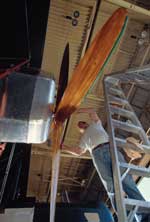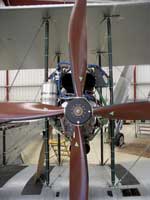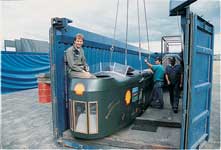|
In 1992, Peter McMillan and Lang Kidby considered what it would take to reenact the Vimy’s three landmark flights of 1919—20. Finding an operable vintage Vimy F.B.27 would be impossible, so they would have to build a new one.
 |
|
| John LaNoue installed the 140-pound propellers made of Tasmanian oak. Courtesy of National Geographic Society. |
|
| |
|
The individual indispensable to the project’s initial adventure was John LaNoue , artist, craftsman, and aviator. John brought together a team of engineers, designers, and other specialists who spent about 30,000 man-hours over 18 months to create the Vimy that was ultimately used to reenact the three flights. Furthermore, to build a modern Vimy, he had to replicate a Vimy factory, complete with the jigs, fixtures, patterns, and special-built machinery required to manufacture the parts.
The goal was to re-create the original aircraft as closely as possible. With the original plans in hand, John consulted with Bill Whitney, an aeronautical engineer, who determined that the early Vickers engineers had done a good job.
The modifications to the design of the replica were limited to improving structural integrity, powerplant reliability, and safety.
| |
 |
| |
Over the three flights, the Vimy had three engine installations. Orenda OE600s were the final. Courtesy of John LaNoue. |
| |
|
The new fuselage was built of 4130 steel tube, which provided a lighter and stronger structure without changing the external visual lines and allowed the installation of larger fuel tanks. The original Vimy was designed as a single-pilot airplane, with the pilot occupying the right side of the cockpit. The new aircraft was outfitted with a throw-over yoke so that it could be flown from either seat of the main cockpit. Negotiating the world’s complex airspace also required the addition of modern radios and avionics.
 |
|
| Twice, after the Australia and South Africa flights, the Vimy was dismantled and shipped in two open-top containers. Courtesy of Eric Durfey. |
|
| |
|
John, Peter, and Lang first worked in a shop in Sonoma, California, where they laid out the framework of the Vimy. The pieces were then moved about 25 miles away to a hangar at Hamilton Field in Novato. On July 7, 1994, John, Peter, Lang, and other team members pulled the completed replica from the hangar for her first public viewing. Just over three weeks later, she make her first flight. In August, the Vimy was separated into forward and aft sections and flown in the cargo hold of a C-5 Galaxy from California to England in preparation for the flight to Australia in 1995.
|
|
|
 |